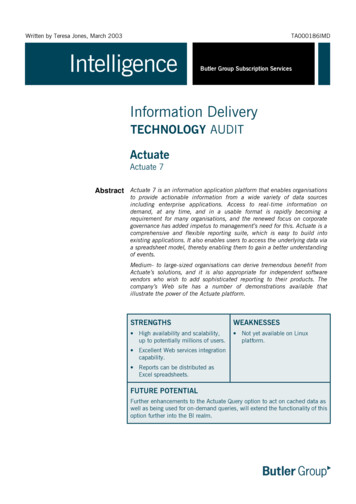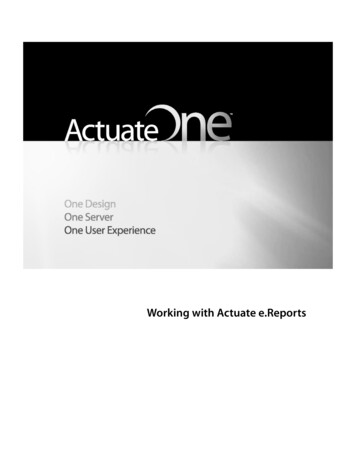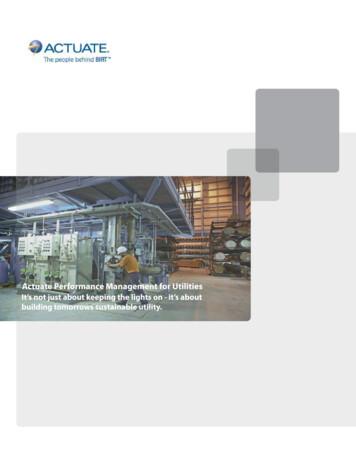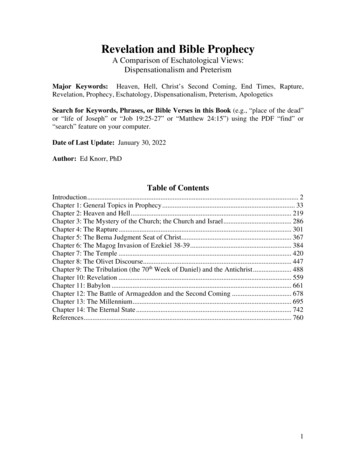
Transcription
Written by Teresa Jones, March 2003TA000186IMDIntelligenceButler Group Subscription ServicesInformation DeliveryTECHNOLOGY AUDITActuateActuate 7Abstract Actuate 7 is an information application platform that enables organisationsto provide actionable information from a wide variety of data sourcesincluding enterprise applications. Access to real-time information ondemand, at any time, and in a usable format is rapidly becoming arequirement for many organisations, and the renewed focus on corporategovernance has added impetus to management’s need for this. Actuate is acomprehensive and flexible reporting suite, which is easy to build intoexisting applications. It also enables users to access the underlying data viaa spreadsheet model, thereby enabling them to gain a better understandingof events.Medium- to large-sized organisations can derive tremendous benefit fromActuate’s solutions, and it is also appropriate for independent softwarevendors who wish to add sophisticated reporting to their products. Thecompany’s Web site has a number of demonstrations available thatillustrate the power of the Actuate platform.STRENGTHSWEAKNESSES High availability and scalability,up to potentially millions of users. Not yet available on Linuxplatform. Excellent Web services integrationcapability. Reports can be distributed asExcel spreadsheets.FUTURE POTENTIALFurther enhancements to the Actuate Query option to act on cached data aswell as being used for on-demand queries, will extend the functionality of thisoption further into the BI realm.
u FUNCTIONALITYActuate is a company with a history of helping organisations to get the fullbenefit of information held within its various applications. In the past, it wasperhaps more well-known for providing information delivery solutions thatenabled IT to generate presentation quality reports for users to access quicklyand easily in a variety of formats. However, the company is now movingmore towards enabling business users to access business-critical informationin more flexible ways, facilitating decision-making and enabling them torespond to changing market conditions.Product Analysis The majority of the stakeholders in an organisation; employees, customers,and business partners, need to access the information that is stored within thevarious applications that are used throughout the enterprise. Being able to dothis in a timely manner provides insight and potentially competitive advantage,but it can be hard to achieve using the applications themselves. Often, simpleaccess to reports is not enough – business users need to access the underlyingdata in order to manipulate and produce subsets or supersets of that data, andhistorically they have tended to resort to independent spreadsheets such asExcel to enable them to do this, although this can lead to inaccuracies andmuch time spent formatting spreadsheets.Actuate has decided to embrace and extend this preference, and therefore inaddition to its reporting suite, provides the ability for business users to designtheir own spreadsheets to access corporate data sources, using the Actuatee.Spreadsheet Designer, and also for them to receive ‘reports’ in the form ofExcel spreadsheets delivered to their desktop.Actuate has continually enhanced its information delivery offering, and withthe latest version also incorporates two new concepts: Information Objects,which can be regarded as a ‘view’ of enterprise data from one or more sources,and Actuate Query, a ‘no training required’ Web-based query tool that businessusers can use to interrogate the Information Objects and view output asDynamic HTML (DHTML), ExcelAdobe PDF, or Actuate’sDesigner allows IT to create a format,own e.Analysis graphical format.The Information Objectsimplified view for business users into enterpriseinformation sources, all the while protecting thoseresources from abuse.The Information Object Designerallows IT to create a simplified viewfor business users into enterpriseinformation sources, all the whileprotecting those resources fromabuse, and avoiding potential runaway queries. These enable the users tosafely but directly interrogate operational data as well as data warehouses.Actuate 7 can also be tightly integrated with existing applications, using builtin Web services capability, thereby ensuring that access to corporate data ispart of each user’s operational role. By delivering personalised information itcan add great value to an organisation, for example, enhancing a Self ServicePortal or a Customer Relationship Management strategy. Additionally, stronginternationalisation capability means that reports can be viewed in a variety oflanguages on request.Butler Group believes that deploying Actuate 7 within an organisation willprovide the ability to empower the vast majority of its stakeholders with accessto timely information – timely because it is the operational data itself that canbe accessed, without affecting performance. Actuate has placed greatemphasis on both scalability and availability, ensuring that information can bedelivered to potentially hundreds of thousands of users without affecting theperformance of operational systems.2
information to the right place – which may be outside the organisation – in atimely manner. Actuate calls these ‘information applications’, by which itmeans customised and personalised views of corporate data from a widevariety of sources, presented in the way that the end-user wishes to use it. Butler Direct LimitedProduct Operation Actuate 7 provides a variety of tools to help organisations to get the rightThe diagram below illustrates the various components of Actuate 7.Actuate 7 Architecture DiagramActuate 7 can be viewed from three main perspectives:- the design anddevelopment of reports, actual deployment of reports, and end-user access toreports.Development FeaturesActuate provides developers with a drag-and-drop interface to enable rapiddesign of reports, with a full visual environment to develop, test, and viewsophisticated designs. Reports can be created from any combination of datasources such as relational databases or Enterprise JavaBeans (EJBs); they canuse visual items such as text or graphics, and can include frames for display.The e.Report Designer tool enables experienced users to create their ownreport both from the components created by developers and by using any of aseries of generic, read-only components provided by Actuate with the product.Developers use e.Report Designer Professional to create and save componentsto a library, and can concurrently access a range of different data sources, fromflat files and XML files to relational databases, CORBA objects, EJBs, and legacyapplication data sources. If necessary, the Actuate Basic scripting language can beused, which is syntactically comparable to Visual Basic and providesprogrammatic control of report generation. New features in version 7 include across-tabulation builder, HyperCharts – the ability to drill down on hyperlinkswithin charts, and support for searching dynamically created controls.3Intelligence uThe new Actuate Information Object Designer enables the IT department tocreate abstractions, or views of the underlying data sources, combining andflattening these in order to provide secure, controlled access to data. Thisenables the users to directly and securely query the Information Object usingActuate Query (see later for more detail), thus freeing up IT support time.Information Objects can encapsulate complex data access logic and exposedata to users in business-friendly terms – for example, providing data fieldswith understandable names.
Actuate’s e.Report Designer Java Edition has similar functionality to thee.Report Designer Professional and can be used to develop reports on anyplatform as well as integrate into a Java application.Where customised Web sites that include reporting content are required, theActive Portal product, a set of Java Server Pages (JSPs) or Active Server Pages(ASPs), can be used, which can be tightly integrated with J2EE- compliantapplication servers or .NET environments. This enables report parametervalues to be entered using check boxes and radio buttons, to provide a morefamiliar and user-friendly interface to the end-user. New features within ActivePortal include one-click client side printing from the browser, the ability tocancel synchronous jobs from the DHTML viewer if they are taking too long,and the option of saving an e.Analysis cube for later offline analysis (see laterfor more on e.Analysis).All Actuate reports can be produced in a variety of formats: DHTML, PDF, and XML,and report content can also be returned as a Reportlet ; a partial DHTML page,which can be integrated into existing Web pages.Actuate’s e.Spreadsheet Designer is a tool that allows Excel-literate businessusers to design their own spreadsheet reports and publish them to the server,if authorised to do so by IT. Actuate states that only 15 minutes of training isrequired to show a business user how to create reports, and the demonstrationgiven to Butler Group certainly backs this up. Full formatting is available usingstyle sheets, and the user can switch between design mode and running thereport until the design is complete. The spreadsheet can then be re-run onupdated data without the need to reformat data or make changes to thespreadsheet. The resulting native Excel spreadsheet can then be distributedeither via the Web or e-mail attachments.From a development perspective, Actuate 7 has been enhanced significantly toimprove integration to existing infrastructure. For example, it now includes SAPBusiness Warehouse access, enabling reporting applications to be integratedmore closely with SAP, and the Designer tools can enable extremely closeintegration with existing applications, both packaged and developed in-house.DeploymentThe Actuate iServer is central to the entire information application platform; itgenerates, manages, and securely delivers business information to the users ofthat information, whether they are inside or outside the organisation. It has amulti-process, multi-threaded architecture that ensures flexibility, performance,and scalability; sharing workload across multiple server nodes, and acrossCPUs within the node, as more users and more reports are included. Reportscan be delivered on demand, with progressive page delivery ensuring that theuser can see any page (not just the first page) of the report as it is processed,rather than waiting for the whole report to be completed.Reports can also be scheduled and held in cache, which for many organisationswill fulfil much of the regular Information Delivery requirements. A cached report isonly run and stored once, and can then be viewed, searched, and have dataextracted from it as required, by many thousands of viewers in multiple formats,with page viewing and searching being subject to user/role privileges. Reports canbe archived, under the control of a Web-based cluster administration console, andagain, only one copy needs to be stored in the archive. Where it is not necessary tosave an on-demand report, for example, where a customer requests a list of theirmost recent transactions, Actuate’s Express Content feature enables reports to begenerated even more rapidly, because they do not need to be stored.Actuate has the ability to store user and role information internally, or can betightly integrated with a number of external security models, such as LightweightDirectory Access Protocol (LDAP)-enabled security directories, providing singlesign-on capability. Both methods provide a manageable security model, ensuringusers can only generate and view a report they should be entitled to see.Optional Page-Level Security means that, for example, a salesperson will only beable to view the details for the accounts that he/she is responsible for, and willsee these as though they are personalised to him/her, starting at page one.4
Butler Direct LimitedThe sales manager may then be able to see summary information by eachsalesperson as well as optionally the detailed accounts, again as though itwere a personalised report. The sales director can see all information, if thesecurity allows, and may well be viewing thousands of pages of detail, as wellas the summary information, which is essential to decision-making.User ExperienceEnd-users find Actuate intuitive and easy to use, and have control over whatinformation they are seeing and the format in which it is presented. This isdone using out-of-the-box functionality such as sophisticated report searching,simple navigation, and single click extraction of report content to multipleformats. Report parameters provide end-user flexibility; by specifying a set ofpreferences, users can control any of the data retrieval and formatting featuresof a report template. These preferences can then be passed to the iServer as aURL string, which is then interpreted. This approach provides end-users withextensible flexibility for report generation, without needing to install client-sidesoftware or provide end-user training.Help text can be associated with data fields on reports to explain importantpoints, such as how the column was calculated, or a note to aid interpretation.Data transformations and calculations are performed at report runtime. Acustomisable table of contents is provided with each report, enabling simpleand rapid navigation through it; for example, to reach summary information.Reports can be viewed at run time in a variety of languages including French,German, and Japanese as well as English. Unicode support ensures thatreports, portal, and Web pages can also be localised in other languages.Support for locales ensures that right to left languages such as Middle Easternlanguages are also supported.Communication with the server cluster can optionally be encrypted usingstandard SSL encryption over HTTPS if required, built on top of the Webservices Simple Object Access Protocol (SOAP) messaging layer.An optional component, e.Analysis Option, enables users to dynamically queryand summarise reports stored in cache, using a pivot table, as well as tographically analyse those reports. Any user with Excel experience can use thistool, since it uses the same approach.The optional new Actuate Query is a Web-based tool that allows end-users tocarry out ad hoc queries on Information Objects, which have been created bythe IT department, with minimal or no training. This enables them to getanswers for themselves directly from the underlying data, without needing torequest specific reports. Butler Group believes that the combination ofInformation Objects and Actuate Query is a powerful new feature that will bewell received by business users who are comfortable with attempting to findthings out for themselves.GeneralActuate 7 provides even greater scalability than the re-architected version 6. Interms of processing and storage scalability, the application was alreadyenterprise-scalable, and now permits potentially millions of users concurrentaccess to large numbers of reports. The storage capacity of the server can beexpanded almost indefinitely by adding Report Encyclopaedia volumes (usedfor storing and accessing reports) and physical disk partitions for additionalstorage capacity.5Intelligence uAs well as processing scalability, Actuate 7 provides clustering capabilities,where the Actuate iServer can run across a cluster of several heterogeneous lowcost machines. Automatic load balancing and transaction partitioning can spreadthe work evenly across a number of machines, and active servers can be used toprovide failover cover. As an organisation’s requirements increase in scale, theapplication can be expanded by adding additional servers to the cluster.
Actuate states that no distinction is made between UNIX and Windows serverswhen added to the Actuate cluster. Any machine can therefore be added to thecluster at any time with little configuration.A key feature of Actuate is that it integrates seamlessly with existingapplications, and often users are not aware that it is Actuate they are using,the end-user interface can be completely re-branded, even providing multiplebrandings across the organisation.The basic Actuate application comes with the Actuate iServer, and either thee.Reporting or e.Spreadsheet options. Other features such as the Designertools, Actuate Query, and the e.Analysis tools are optional extras.Product Emphasis With the new version of Actuate 7, the company has moved further towardsthe ability to empower the majority of users within (and outside) theorganisation with timely information. Much progress has been made inscalability and performance, which were already hot features of the solution.Additionally, any organisation that is considering providing queryingcapabilities to large numbers of users needs to seriously look at the cost ofownership of the underlying software and hardware required to deliver this,and Actuate performs competitively here.Whilst other reporting providers have some Web services functionality, Actuatehas embraced the Web services concept fully, and provides extensive directconnectivity to both J2EE and .NET applications.u DEPLOYMENTActuate 7 can be deployed on a wide variety of platforms. The serverssupported include Windows NT 4.0 Server, Windows 2000 Server, andMicrosoft Windows XP Professional, Solaris, HP-UX, and AIX. On the clientside, Microsoft Internet Explorer 5.0, 5.5, and 6.0, or Netscape Navigator 4.7or 6.2 is required. Platforms and browsers may be subject to change.The suite has been specifically designed to support a large number of differentdatabases, including Oracle 7, 8, 8i, and 9i; IBM DB2; Informix; Sybase;Progress; and Microsoft SQL Server 6.5, 7.0, or 2000; and ODBC-compliantdatabases.Information can also be taken directly from any J2EE application, byincorporating Java Objects, EJBs, or Java applets. In addition, applicationswritten using Visual Basic, C#, C , .NET, and COM components can all beaccessed directly by Actuate.Actuate can be implemented on Web Servers, including Microsoft InternetInformation Server, Apache HTTP Server, IBM HTTP Server, and iPlanet WebServer 6.0. The product can also be implemented using Servlet Engines andApplication Servers, including BEA WebLogic Server and IBM WebSphere.Actuate has actively embraced the Web services concept by providing a richSOAP API, which enables comprehensive integration with J2EE, .NET, legacy,and other third-party applications. All of the available functionality, such ascontrol over object management, user management, and scheduling, is thusexposed via a SOAP based API, enabling the automation of entire tasks –including user administration, profile creation, privileges, content subscription,and search capabilities.In order to develop report components Visual Basic skills may be required.Once components have been developed, a competent Excel or Access businessuser would be able to use them to create simple new reports. The intuitivenature of the product means that end-users who are familiar with a Webbrowser will require no training. A J2EE-based sample application is includedwith the product to enable rapid report development, giving insight into thetechnology.6
In support of internationalisation, all data is held internally in Unicode format,which is like a master set of all character code pages, enabling the use of avery wide range of languages, including double-byte languages such asChinese. Support for locales is also comprehensively addressed by Actuate 7. Butler Direct LimitedBenchmark tests, published on the company’s Web site, indicate that Actuateis capable of supporting in excess of a million users, and these effectivelysupport the company’s claims of low operational ownership costs.Actuate offers enterprise-standard 24x7 support, as well as training,consulting, integration, and customisation services. Tr
Actuate Actuate 7 Abstract Actuate 7 is an information application platform that enables organisations to provide actionable information from a wide variety of data sources including enterprise applications. Access to real-time information on demand,











